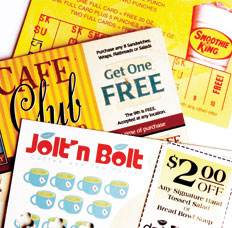For years Brandon Ansel frequented Steak n Shake on a monthly basis. He was a regular, a loyalist in the purest sense. Slowly, however, his habits changed, and Steak n Shake faded completely from his mealtime routine for more than a year.
Then one day Ansel got a promotional coupon in the mail, and he was back on the horse.
“That coupon came because [Steak n Shake] knew I was once a regular, and it got me back in the door,” he says. “I’ve now been back there five times in the last month alone.”
Ansel owns and operates a Biggby Coffee and a Roly Poly in the town of Jackson, Michigan, and recognizes the importance of the loyalty programs he has implemented at his two quick-service locations. Even though Ansel knows he already has a loyal base of customers, he also knows habits change, and a successful loyalty program, he says, helps guard against the fallout from customers’ fickle dedications.
“We are creatures of habit, and loyalty programs reinforce habits,” Ansel says. “If we don’t have a way to constantly stay in front of customers, we run the risk of them forgetting about us and developing other habits.”
Evidence seems to be growing in support of the potential power loyalty programs could have in the quick-service sector. A recent study conducted by First Data, an information commerce provider that processes point-of-sale transactions, surveyed more than 2,400 U.S. consumers about their attitudes and behaviors toward loyalty programs in the retail and travel industries. It concluded that consumers are more eager than ever before to sign up for reward programs.
But while 60 percent of quick-serve loyalty program participants report using their rewards membership “every time” or “most times” when making a purchase, the survey also shows that the quick-service industry has the second-lowest rate of participation in retail loyalty programs, edging out only sports teams. According to the study, the low rate of quick-service participation in these programs is “primarily due to the limited availability and newness of such programs.”
The time seems to be ripe for owners and operators to step up their loyalty efforts.
“For operators, loyalty programs are first and foremost a great way to bring better insight into a consumer base,” says Stuart Kiefer, vice president of loyalty solutions at First Data. “Most of these quick serves don’t know much, if anything, about their individual consumers, and the nice thing is that loyalty programs provide all the metrics you need to know your customer base.”
But gathering that data is the easy part, and experts say there is more to running a successful loyalty program than simply offering a frequent-eater card or rewards coupons.
Chuck Sullivan is director of hosted solutions for Radiant Systems, which provides technology solutions for loyalty programs in the hospitality and retail industries. He says the most critical consideration when rolling out a loyalty program is its ease of use on the front end. “It cannot have any impact on the speed of service,” Sullivan says. “You can have the best loyalty program in the world, but if it slows down your line it defeats the purpose.”
Sullivan says quick-service merchants should also make sure the program is as simple as possible for customers. If they have to jump through complicated hoops to gain their reward, he says, the program will not be effective. Finally, the rewards have to be meaningful to each individual customer.
Bob Paine, restaurant category consultant for Affinity Solutions, says operators should not only consider broad-based loyalty programs, but also ones that focus on a niche product or individualized consumer reward. For example, Paine says he sees great success in Dairy Queen’s Blizzard Fan Club, which rewards new members with a free Blizzard Treat e-mail coupon when they sign up as well as a buy-one-get-one e-mail coupon on their birthdays.
“The quick-service ice cream business has been keen on the idea of birthday loyalty rewards for some time now,” Paine says. “Not only does a free birthday Blizzard sound good, it’s also an opportunity for Dairy Queen to sell a bigger product when customers come in to claim their reward.”
While these approaches are all positive, Lori Walderich, CEO of IdeaStudio, a national restaurant-marketing consulting firm, says they only scratch the surface of the loyalty equation. “Too many quick serves just pull a discount or coupon out of their hats and think that’s going to generate a warm and fuzzy feeling for the brand,” she says. “It might generate a spike in sales, but management would be seriously misguided to conflate that with loyalty.”
Walderich says successful loyalty programs should ultimately aim at building a long-term relationship with customers, which means finding ways to not only reward repeat visits, but also ways to reward an increased frequency in those visits.
“Quick-service operators need to remember that programs work best if they’re structured in a way that rewards customers when they step up their loyalty just a notch,” Walderich says. “So maybe you turn a twice-a-month customer into a once-a-week customer, or turn a once-a-week customer into a twice-a-week-or-more customer.”
The loyalty relationship is also about feedback. Steen Anderson, co-founder and vice president of 5th Finger, a mobile-marketing agency that has overseen such national loyalty campaigns as My Coke Rewards, says operators need to have an open “feedback loop” with loyalty members. “You need to give the customer a chance to either choose a different offer or ask them what they prefer,” Anderson says. “You can use that as a poll, and you will know who prefers what.”
Eric Abrams, sales and marketing manager for Fishbowl Marketing, says social media sites like Facebook and Twitter are fantastic resources for building loyalty.
“Just be sure that when you start utilizing these sites you are prepared to pay attention,” Abrams says. “Guests who engage with your brand through these channels expect to be acknowledged and will graciously reward you if you do.”













